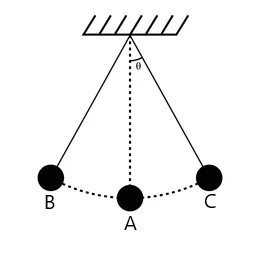A simple pendulum is a heavy mass attached to a light inextensible string. The heavy mass is referred to as the bob and we refer to it as heavy because it should contribute the vast majority, if not all, of the mass of the system (consisting of bob and string).
Image Credits: Unacademy

The period of a pendulum
The period of a pendulum is the time taken for it make one complete oscillation - a full to-and-fro movement (e.g. from left to right and back to the left). Under ideal conditions, the period of the simple pendulum is dependent upon the length of the pendulum:
$$T=2\pi\sqrt{\frac{l}{g}}$$
where $g$ is acceleration due to gravity ($9.81 ms^{-2}$).
Example
Find the period of a simple pendulum whose length is $0.4m$.
Using the formula: $$T=2\pi\sqrt{\frac{l}{g}}$$ We substitute the values for the length and acceleration due to gravity to get: $$T=2\pi\sqrt{\frac{0.4 m}{9.81 ms^{-2}}}$$ $$T=1.27 s$$
Practice
- Find the period of a simple pendulum whose length is $1.3m$.
- Determine the length of a simple pendulum whose period is $0.23s$.
1) What will happen to the period of the pendulum if we increase the length of the pendulum?
- Decrease
- Remain the same
- Increase
2) Under ideal conditions, the period of a pendulum is dependent on the angle of release.
- True
- False
